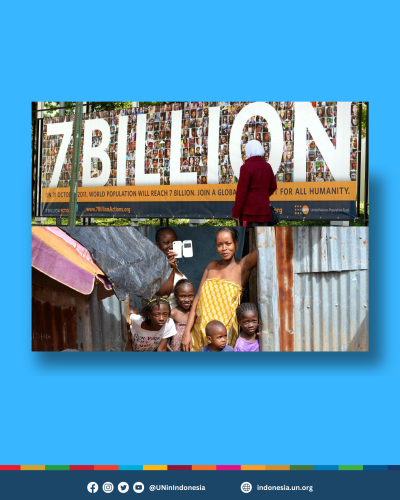World Population Day - 11 July

Background
World Population Day, which seeks to focus attention on the urgency and importance of population issues, was established by the then-Governing Council of the United Nations Development Programme in 1989, an outgrowth of the interest generated by the Day of Five Billion, which was observed on 11 July 1987.
By resolution 45/216 of December 1990, the United Nations General Assembly decided to continue observing World Population Day to enhance awareness of population issues, including their relations to the environment and development.
The Day was first marked on 11 July 1990 in more than 90 countries. Since then, a number of a number of UNFPA country offices and other organizations and institutions commemorate World Population Day, in partnership with governments and civil society.
The UN and Population
The UN Population Division collaborates closely with the agencies, funds, programmes and bodies of the United Nations system in the implementation of the work programme on population and in the follow-up to the International Conference on Population and Development. United Nations missions, national Government offices, United Nations offices, researchers, media representatives and the public regularly consult the Population Division regarding population estimates and projections, and information and analyses on population and development issues.
At its thirty-eighth session, the Statistical Commission requested the United Nations Statistics Division and other international agencies to increase their technical assistance to national statistical offices in order to strengthen national capacity for the implementation of the 2010 World Programme on Population and Housing Censuses. In addition, the Commission requested countries to begin implementation of the revised Principles and Recommendations for Population and Housing Censuses.
UNFPA works with many partners, both within and outside the United Nations system, including Governments, non-governmental organizations, civil society, faith-based organizations, religious leaders and others, to achieve its mission. To better respond to local needs, UNFPA increasingly devotes resources to country-led efforts, placing emphasis on country-focused and country-led implementation to achieve improved results, at the same time addressing mutual accountability and strengthening harmonization and alignment.
UNFPA works to support family planning by: ensuring a steady, reliable supply of quality contraceptives; strengthening national health systems; advocating for policies supportive of family planning; and gathering data to support this work. UNFPA also provides global leadership in increasing access to family planning, by convening partners – including governments – to develop evidence and policies, and by offering programmatic, technical and financial assistance to developing countries
Nine standards to uphold the human right to family planning
- Non-discrimination: Family planning information and services cannot be restricted on the basis of race, sex, language, religion, political affiliation, national origin, age, economic status, place of residence, disability status, marital status, sexual orientation or gender identity.
- Available: Countries must ensure that family planning commodities and services are accessible to everyone.
- Accessible: Countries must ensure that family planning commodities and services are accessible to everyone.
- Acceptable: Contraceptive services and information must be provided in a dignified manner, respecting both modern medical ethics and the cultures of those being accommodated.
- Good quality: Family planning information must be clearly communicated and scientifically accurate.
- Informed decision-making: Every person must be empowered to make reproductive choices with full autonomy, free of pressure, coercion or misrepresentation.
- Privacy and confidentiality: All individuals must enjoy the right to privacy when seeking family planning information and services.
- Participation: Countries have an obligation to ensure the active and informed participation of individuals in decisions that affect them, including health issues.
- Accountability: Health systems, education systems, leaders and policymakers must be accountable to the people they serve in all efforts to realize the human right to family planning.
This part of the article has been published in the United Nations' site in this link: https://www.un.org/en/observances/world-population-day/background.
Reaching a global population of eight billion is a numerical landmark, but our focus must always be on people. In the world we strive to build, 8 billion people means 8 billion opportunities to live dignified and fulfilled lives. - UN Secretary-General António Guterres
A world of 8 billion: Towards a resilient future for all - Harnessing opportunities and ensuring rights and choices for all
In 2011, the world reached a population of 7 billion. This year, the number will hit 8 billion, prompting the attendant responses. Some will marvel at the advancements in health that have extended lifespans, reduced maternal mortality and child mortality and given rise to vaccine development in record time. Others will tout technological innovations that have eased our lives and connected us more than ever. Still others will herald gains in gender equality.
But progress is not universal, throwing inequality into razor-sharp relief. The same concerns and challenges raised 11 years ago remain or have worsened: Climate change, violence, discrimination. The world reached a particularly grim milestone in May: More than 100 million forcibly displaced worldwide.
In an ideal world, 8 billion people means 8 billion opportunities for healthier societies empowered by rights and choices. But the playing field is not and has never been even. Based on gender, ethnicity, class, religion, sexual orientation, disability and origin, among other factors, too many are still exposed to discrimination, harassment and violence. We do ourselves no favors when neglecting those left behind.
Let no alarmist headline distract from the work at hand: investing in human and physical capital for inclusive, productive societies that uphold human and reproductive rights. Only then can we tackle the enormous challenges facing our planet and forge a world where health, dignity and education are rights and realities, not privileges and empty promises. In a world of 8 billion, there must always be space for possibility.
Did you know?
- Since the middle of the 20th century, the world has experienced unprecedented population growth. The world’s population more than tripled in size between 1950 and 2020.
- The growth rate of the world’s population reached a peak between 1965 and 1970, when human numbers were increasing by an average of 2.1% per year.
- During the period from 2000 to 2020, even though the global population grew at an average annual rate of 1.2%, 48 countries or areas grew at least twice as fast: these included 33 countries or areas in Africa and 12 in Asia.
- The life span of adults in the developed world has increased since the middle of the 20th century - the number of people reaching the age of 100 years has never been greater than it is today.
- Worldwide, the number of deaths relative to the size of the population has been declining since the 1950s, Over the next several decades, projections by the United Nations assume a continuing gradual decrease in age-specific mortality rates.
World Population Trends
It took hundreds of thousands of years for the world population to grow to 1 billion – then in just another 200 years or so, it grew sevenfold. In 2011, the global population reached the 7 billion mark, it stands at almost 7.9 billion in 2021, and it's expected to grow to around 8.5 billion in 2030, 9.7 billion in 2050, and 10.9 billion in 2100.
This dramatic growth has been driven largely by increasing numbers of people surviving to reproductive age, and has been accompanied by major changes in fertility rates, increasing urbanization and accelerating migration. These trends will have far-reaching implications for generations to come.
The recent past has seen enormous changes in fertility rates and life expectancy. In the early 1970s, women had on average 4.5 children each; by 2015, total fertility for the world had fallen to below 2.5 children per woman. Meanwhile, average global lifespans have risen, from 64.6 years in the early 1990s to 72.6 years in 2019.
In addition, the world is seeing high levels of urbanization and accelerating migration. 2007 was the first year in which more people lived in urban areas than in rural areas, and by 2050 about 66 per cent of the world population will be living in cities.
These megatrends have far-reaching implications. They affect economic development, employment, income distribution, poverty and social protections. They also affect efforts to ensure universal access to health care, education, housing, sanitation, water, food and energy. To more sustainably address the needs of individuals, policymakers must understand how many people are living on the planet, where they are, how old they are, and how many people will come after them.
This part of the article has been published in the United Nations' site in this link: https://www.un.org/en/observances/world-population-day.














